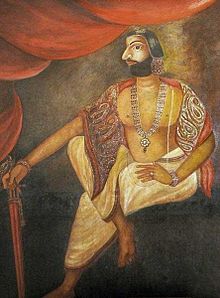
Back मार्तण्ड वर्मा Hindi ಮಾರ್ತಾಂಡ ವರ್ಮ Kannada മാർത്താണ്ഡവർമ്മ Malayalam Marthanda Varma Portuguese மார்த்தாண்ட வர்மர் Tamil మార్తాండవర్మ Tegulu Мартанда Варма Ukrainian Marthanda Varma Vietnamese Marthanda Varma ZH-MIN-NAN
| Marthanda Varma | |||||
|---|---|---|---|---|---|
| King of Travancore | |||||
 A depiction of Marthanda Varma | |||||
| Reign | 1729 – 7 July 1758 | ||||
| Predecessor | Rama Varma | ||||
| Successor | Rama Varma ("Dharma Raja") | ||||
| Born | Anizham Thirunal 1706 Attingal, Venad | ||||
| Died | 7 July 1758 (aged 53) Padmanabhapuram, Kingdom of Travancore | ||||
| |||||
| Kulasekhara Dynasty | House Of Venad | ||||
| Father | Raghava Varma Koyil Thampuran of Kilimanoor | ||||
| Mother | Karthika Thirunal Umadevi of Attingal | ||||
| Religion | Hinduism | ||||
Anizham Thirunal Marthanda Varma (Malayalam: അനിഴം തിരുനാൾ മാർത്താണ്ഡവർമ്മ) was the founding monarch of the southern Indian Kingdom of Travancore (previously Venadu) from 1729 until his death in 1758.[1] He was succeeded by Rama Varma ("Dharma Raja") (1758–98).[2]
Marthanda Varma defeated the Dutch East India Company forces at the Battle of Colachel in 1741. He also put an end to the ettuveetil pillamars and the ettara yogam council and took the full power as a king. The Yogakars and Pillamars were always against the Royal Family of Venad (Padmabhaswamy Temple Judgement page :16) He then adopted a European mode of discipline for his army and expanded his kingdom northward (to what became the modern state of Travancore).[1] He built a sizeable standing army of about 50,000 nair men, as part of designing an "elaborate and well-organised" war machine,[2] with the role of the travancore army and fortified the northern boundary of his kingdom (Travancore Lines).[2] His alliance in 1757 with the ruler of Kochi (Cochin), against the northern Kingdom of Calicut, enabled the kingdom of Kochi to survive.[1]
Travancore under Marthanda Varma made a deliberate attempt to consolidate its power by the use of Indian Ocean trade.[2] It was the policy of Marthanda Varma to offer assistance to Syrian Christian traders (as a means of limiting European involvement in ocean trade). The principal merchandise was black pepper, but other goods also came to be defined as royal monopoly items (requiring a license for trade) between the 1740s and the 1780s.[3][2] Eventually, Travancore challenged and broke the Dutch blockade of the Kerala coast.[3]
Trivandrum became a prominent city in Kerala under Marthanda Varma.[4] He undertook many irrigational works, built roads and canals for communication and gave active encouragement to foreign trade.[5] In January, 1750, Marthanda Varma decided to "donate" his kingdom to the last Tiruvadi Sri Padmanabha (Vishnu) and thereafter rule as the deity's "vice-regent" (Sri Padmanabha Dasa).[6][7] Marthanda Varma's policies were continued in large measure by his successor, Rama Varma ("Dharma Raja").
- ^ a b c Noble, William G., Kerala at the Encyclopædia Britannica
- ^ a b c d e Subrahmanyam, Sanjay. The south: Travancore and Mysore "India". Encyclopædia Britannica.
- ^ a b Subrahmanyam, S. (1988). Commerce and State Power in Eighteenth-Century India: Some Reflections. South Asia Research, 8(2), 97–110.
- ^ Thiruvananthapuram at the Encyclopædia Britannica
- ^ Bipan Chandra "History of modern India"
- ^ Cite error: The named reference
Chaitanya1983was invoked but never defined (see the help page). - ^ Cite error: The named reference
Aswathy Thirunal 1998 168–170, 179–180, 595–602was invoked but never defined (see the help page).